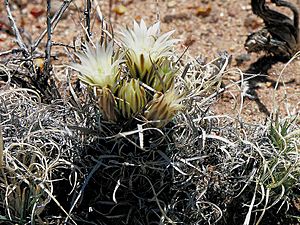Paperspine fishhook cactus facts for kids
Quick facts for kids Paperspine fishhook cactus |
|
|---|---|
 |
|
| Conservation status | |
| Scientific classification | |
| Kingdom: | |
| (unranked): | |
| (unranked): | |
| (unranked): | |
| Order: | |
| Family: | |
| Subfamily: | |
| Tribe: |
Cacteae
|
| Genus: | |
| Species: |
S. papyracanthus
|
| Binomial name | |
| Sclerocactus papyracanthus (Engelm.) N.P.Taylor
|
|
| Synonyms | |
|
Echinocactus papyracanthus |
|
Sclerocactus papyracanthus is a special kind of cactus. People often call it the paperspine fishhook cactus. Other names include grama grass cactus and paper-spined cactus. This unique plant grows in North America. You can find it in places like Arizona, New Mexico, and Texas in the United States. It also grows in Chihuahua, a state in northeastern Mexico.
Where This Cactus Lives
This interesting cactus likes to grow in specific places. It is often found in pinyon-juniper woodlands. These are areas with small pine trees and juniper bushes. It also lives in the Chihuahuan Desert grasslands.
The cactus usually grows among grama grass. This is a type of grass from the Bouteloua family. It especially likes to hide near blue grama grass (Bouteloua gracilis). It can be quite tricky to spot this cactus! Its spines look very much like the leaves of the grass. This helps the cactus blend in with its surroundings.
What This Cactus Looks Like
The Sclerocactus papyracanthus is a small cactus. It usually grows up to about 8 centimeters (3 inches) tall. It can be up to 2.5 centimeters (1 inch) wide.
This cactus is covered in many spines. There are so many spines that they hide the green stem underneath. These spines are usually white, tan, or gray. They feel like paper, which is why it's called the "paperspine" cactus. Sometimes, the spines can be twisted or wavy.
The flowers of this cactus are also very pretty. They are about 2.5 centimeters (1 inch) long. The outer parts of the flower, called tepals, are light in color. They often have a dark stripe down the middle. After the flower, a fruit grows. This fruit is green and becomes dry when it is ready.
See also
 In Spanish: Sclerocactus papyracanthus para niños
In Spanish: Sclerocactus papyracanthus para niños


